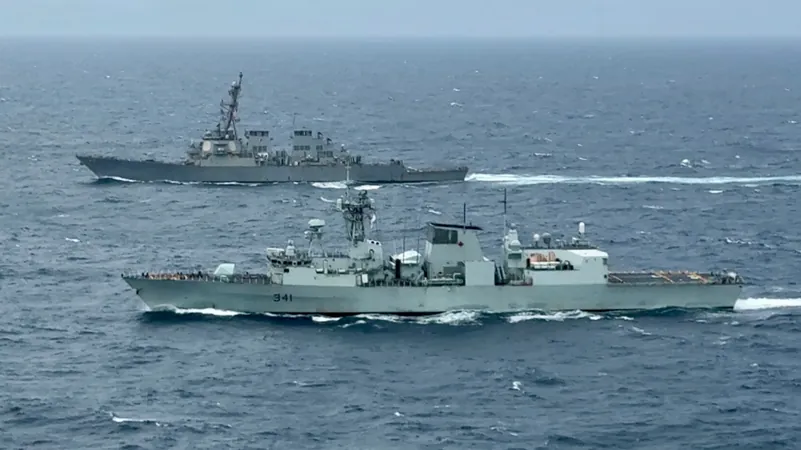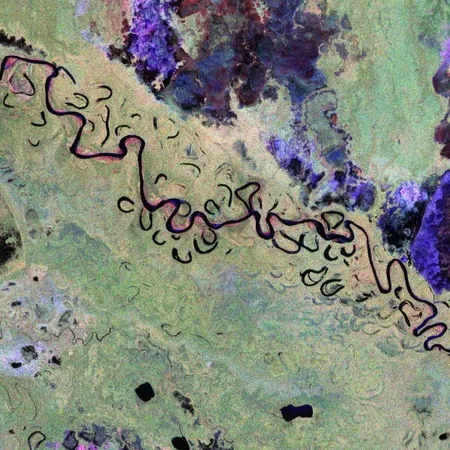
Tensions Rise as Canada and U.S. Warships Team Up in the South China Sea
2025-01-13
Author: Sophie
Introduction
In a remarkable show of allied strength, the Canadian HMCS Ottawa and the American USS Higgins have joined forces in the increasingly contested waters of the South China Sea. On Thursday, these warships traveled southward towards the militarized Spratly Islands, an area of significant geopolitical tension due to China's growing naval presence.
China's Assertive Presence
As soon as the allied ships began their operations, they were trailed by two vessels from the People's Liberation Army Navy, namely the destroyer "Changsha" and the warship "Yuncheng." This shadowing serves as a stark reminder of China’s assertiveness in asserting control over the region, which Beijing claims almost in its entirety despite an international court ruling in 2016 deeming these claims invalid.
Over the past decade, China has aggressively organized military operations in the region, building airstrips on reefs and deploying missile systems on various islands, raising concerns about its intentions on the global stage. The South China Sea is not only a vital shipping route, with one-third of global maritime traffic passing through it, but it is also believed to hold approximately 11 billion barrels of untapped oil reserves beneath its seabed. Control of these waters could grant China significant strategic and military advantage across the Indo-Pacific.
Alliance Strengthening
The collaboration between the Royal Canadian Navy and the U.S. Navy has strengthened throughout the past year, with multiple joint operations planned to maintain stability and enforce a rules-based maritime order. This effort is part of a broader initiative called Operation Horizon, which engages multiple nations to address security concerns in the Indo-Pacific.
U.S. Navy Commander James Billings emphasized the importance of these joint exercises, telling CTV News, “Working together, proving this interchangeability, is one step closer to being able to plug and play should conflict arise.” HMCS Ottawa Commanding Officer Adriano Lozer echoed these sentiments, affirming that their collaborative training has enhanced operational capabilities in scenarios that could arise in potential conflict.
Intelligence Gathering and Risks
Furthermore, HMCS Ottawa has an adept and specialized crew from the Royal Canadian Air Force operating a CH-148 Cyclone helicopter, which is deployed frequently to gather crucial intelligence and ensure safe navigation through volatile waters. During their operations, a recent flight near the Chinese-constructed Firey Cross airbase underscored the tense dynamics at play. A Chinese warship made a radio call instructing the Canadian helicopter to alter course to avoid potential misunderstandings, demonstrating the fine line crews must navigate when operating in contested airspace.
In another concerning incident, Canadian air combat systems officer Captain Theodore Yan recounted an alarming interaction with a Chinese jet during a mission in mid-October 2023. The situation escalated dangerously as the Chinese aircraft dived lower towards them, eventually firing flares that illuminated the skies. Fortunately, the Canadian crew managed to return to HMCS Ottawa unharmed, yet this encounter served as a stark reminder of the ongoing risks these military operations entail in the contested region.
Conclusion
As the geopolitical landscape in the South China Sea continues to evolve, the collaboration between Canada and the U.S. signals a strong response to ensure stability and deter unilateral actions by nations, particularly China, that threaten regional peace. Will this united front be enough to prevent further escalation, or are we witnessing just the beginning of a much larger conflict? Stay tuned as the situation unfolds.









 Brasil (PT)
Brasil (PT)
 Canada (EN)
Canada (EN)
 Chile (ES)
Chile (ES)
 Česko (CS)
Česko (CS)
 대한민국 (KO)
대한민국 (KO)
 España (ES)
España (ES)
 France (FR)
France (FR)
 Hong Kong (EN)
Hong Kong (EN)
 Italia (IT)
Italia (IT)
 日本 (JA)
日本 (JA)
 Magyarország (HU)
Magyarország (HU)
 Norge (NO)
Norge (NO)
 Polska (PL)
Polska (PL)
 Schweiz (DE)
Schweiz (DE)
 Singapore (EN)
Singapore (EN)
 Sverige (SV)
Sverige (SV)
 Suomi (FI)
Suomi (FI)
 Türkiye (TR)
Türkiye (TR)
 الإمارات العربية المتحدة (AR)
الإمارات العربية المتحدة (AR)